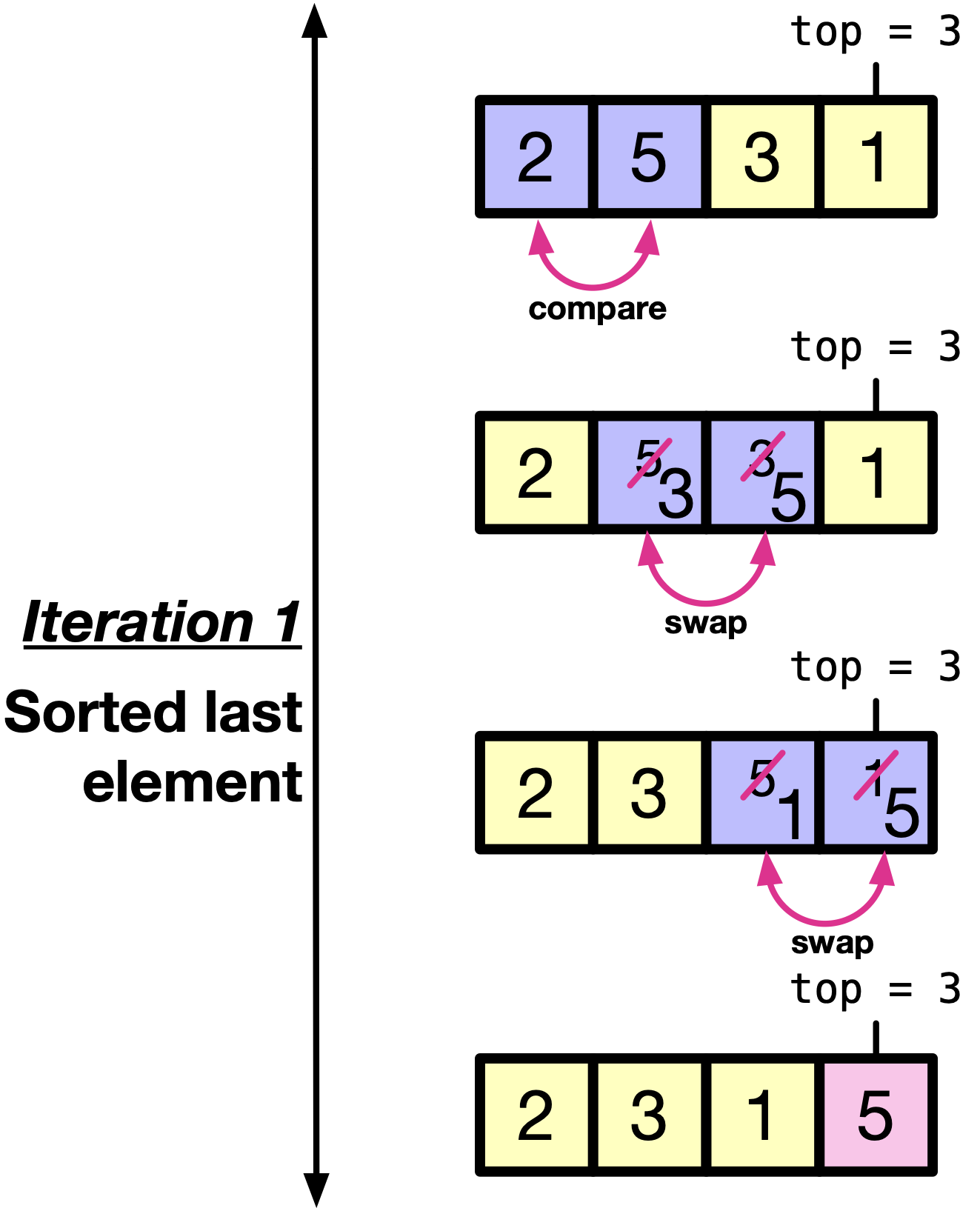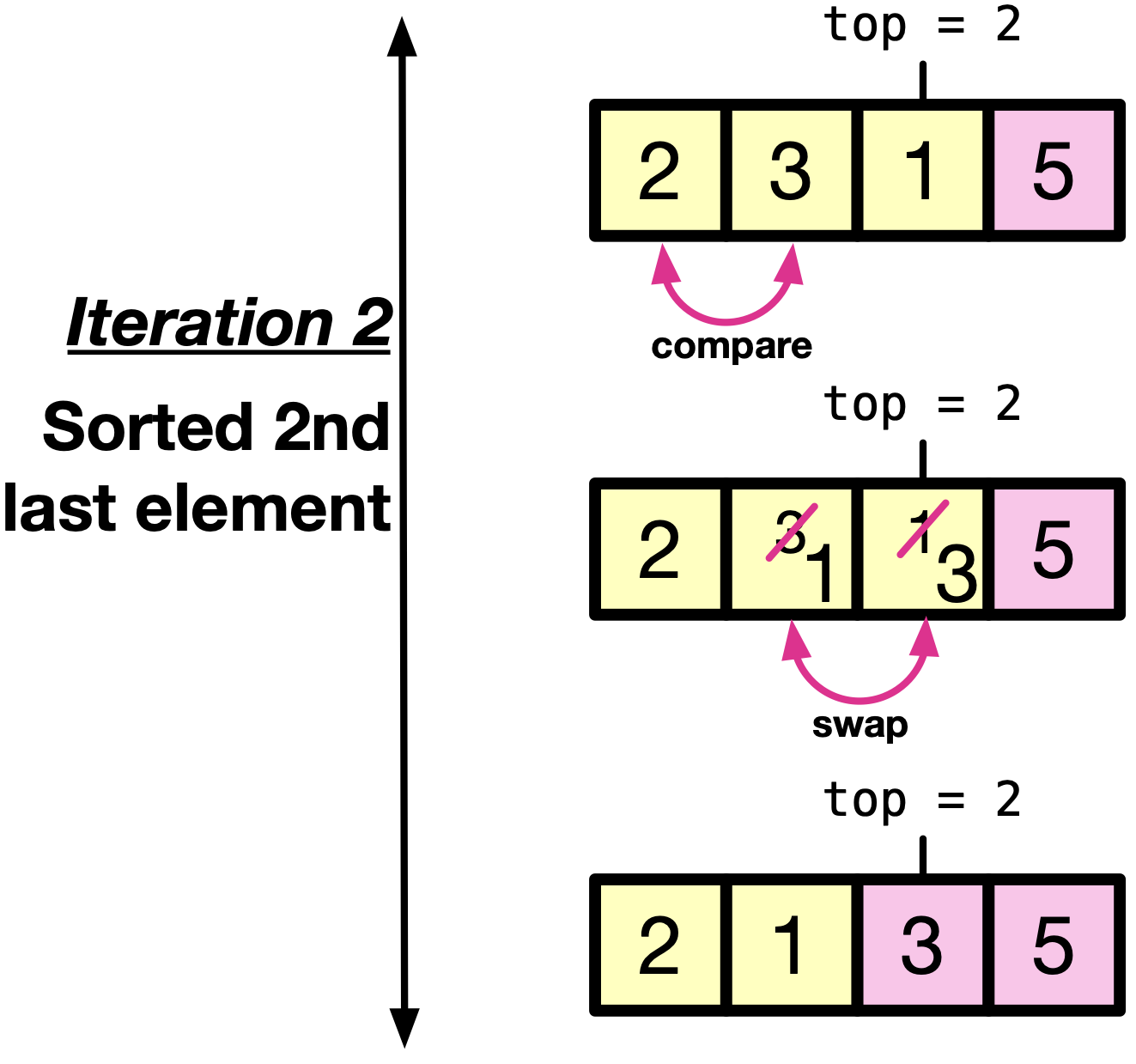Bubble sort
Contents
14.3. Bubble sort#
Bubble Sort is a simple sorting algorithm that works by repeatedly stepping through the list, comparing each pair of adjacent elements and swapping them if they are in the wrong order. The process is repeated until the entire list is sorted. The algorithm gets its name because the smaller elements “bubble” to the top of the list, while the larger elements “sink” to the bottom.
14.3.1. Algorithm#
Bubble sort works as follows:
In the first iteration, compare the first element with the second element. If the first element is greater than the second element, swap them. Otherwise, do nothing. Then, compare the second element with the third element. If the second element is greater than the third element, swap them. Otherwise, do nothing. The process repeats till the last element of the array. After the first iteration, the last element of the array is sorted, and is holding the maximum element of the array. We “bubbled” the last element to the end of the array.

In the second iteration, compare the first element with the second element. If the first element is greater than the second element, swap them. Otherwise, do nothing. Then, compare the second element with the third element. If the second element is greater than the third element, swap them. Otherwise, do nothing. The process repeats till the second last element of the array. After the second iteration, the last two elements of the array are sorted, holding the maximum two elements of the array.

In the third iteration, compare the first element with the second element. If the first element is greater than the second element, swap them. Otherwise, do nothing. The process repeats till the third last element of the array. After the third iteration, the last three elements of the array are sorted, holding the maximum three elements of the array. In our example, this is the last iteration because the array has only four elements. Hence, the maximum number of iterations is the size of the array minus one.

Save iterations. To save iterations, we can stop the algorithm if the array is already sorted at any point in time. We can do this by keeping track of whether a swap has occurred in the current iteration. If no swap has occurred, we can stop the algorithm.
14.3.2. Pseudocode#
We write pseudocode for bubble sort as follows:
Set
topton - 1, wherenis the size of the array.Set index
indto0.Set
sortedtofalse.Compare the element at index
indwith the element at indexind + 1. If the element at indexindis greater than the element at indexind + 1, swap them. If we swap, this means the array wasn’t sorted and their were two elements out of order, so we setsortedtofalse. Otherwise, do nothing.Increment
indby1.Repeat steps \(4\) and \(5\) until
indis equal totop.If
sortedistrue, stop the algorithm. Otherwise, settoptotop - 1and go to step \(2\).
14.3.3. Implementation#
We implement bubbble sort as follows. In lines \(1\) to \(5\), we implement the swap function that swaps two int values. We implemented the swap function before in Section 6.3. Download bubble-sort.c if you want to play with the code.
Code
#include <stdio.h> #include <stdbool.h> void swap(int *x, int *y) { int temp = *x; *x = *y; *y = temp; }
void printArray(int list[], int n) { for (int i = 0; i < n; i++) { printf("%d ", list[i]); } printf("\n"); }
void bubbleSort(int list[], int n) { bool sorted = false;
for (int top = n - 1; top > 0 && !sorted; top--) { sorted = true; for (int i = 0; i < top; i++) { if (list[i] > list[i + 1]) { swap(&list[i], &list[i + 1]); sorted = false; } } printf("After iteration %d: ", n - top); printArray(list, n); } }
int main(void) { int list[4] = {2, 5, 3, 1};
bubbleSort(list, 4); printArray(list, 4); return 0; }
Quiz
0 Questions
